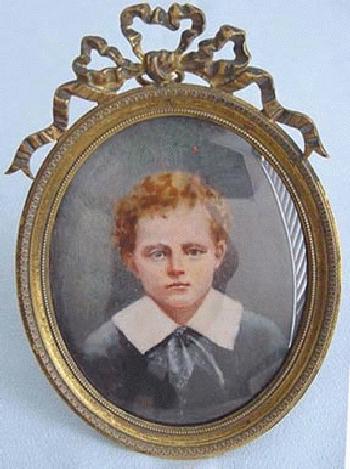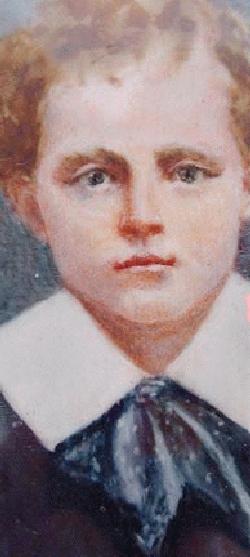
Eton Collars: France

Figure 1.--We have noted this hand painted miniature portrait of a French boy. The image is undated and the artist and subject unidentified. We believe it was painted in the late 19th century. It is painted on ivory and set in a bronze hanging or easel frame with a convex glass.
|
|
We have noted French boys wearing Eton collars, but the style was not nearly as common in France as it was in England. While we have noted some images, we have not yet acquired any written assessments of the Eton collar in France, but note French boys wearing them by the late 19th century. We have not noted French boys wearing them in the early 19th century, but our images of this period are still very limited. We are not sure when the style first appeared in France or how common it was. It was probably seen as an English style. As is the case of many such imports, the French developed their own stylistic inovations. We have not noted French boys wearing as severely starched or stiff Eton collars as English boys, although some of the French collars are quite large. We suspect that it was a fashion most common with boys from affluent families. As in England, Eton collars were worn both with and without neckwear. A variety of neckwear was used.
Translation
We thought that the French term for Eton collars is "collier d'Eton". A French reader tells us, however, that the correct term is "col Eton".
Chronology
Eton collars in France as in England were detachable collars. Eton collars were worn by French boys in the mid- and late-19th century, although we have few details at this time. The image here looks to be a late-19th century minature (figure 1). HBC notes seeing French boys wearing Eton collars before World War I (1914-18), but far fewer examples of boys wearing Eton collars after the War. A French reader report that Eton collars in the 20th it was not commonly worn by little boys. He reports, "The Eton collar for boys was not common after World War I. French mothers prefered all sort of standard collar. For younger boys the the Peter Pan collar was especially popular after 1936. Probably the Eton style did not seem appropriately juvenile."
Collar Style
A HBC reader tells us, "I think the French collars tended to be larger and sit across the shoulders type, rather like the 17th century Puritan collar. Also French Eton collars were not as stiffly starched as the English Etons. The minature here is a good example."

Figure 2.--We have noted this hand painted miniature portrait of a French boy. The image is undated and the artist and subject unidentified. We believe it was painted in the late 19th century. It is painted on ivory and set in a bronze hanging or easel frame with a convex glass.
|
|
We have very few images of French boys wearing Eton collars. As a result, we can not yet assess what clorges were worn with Eton collars. We can make some preliminary observations. English boys generally wore Eton collars with a suit jacket. We note some images of French boys wearing Eton collars with a shirt-like jacket during the eraly 20th century. Most images show boys wearing Eton collars with kneepants or bloomer knickers.
Bows
Most of the French images we have of boys wearing Eron collars show the boys wearing thrm with bows. Notice the boy here is wearing a blue pola-dot bow (figure 1). Many English boys wore their Eton collars without bows or other neckwear. French boys may havde also worn Eton collars in this way, but this is not yet conformed with the images available to us.
We are not sure how common Eton collars were in France. We do note them being worn, but our archive of French photographs is more limited than our British and American archives. As best we can tell the Eton collar was less commonly worn by French boys. Many of the images we have found are rather forman and fancy outfits. We see Eton collars in many commercial post cards. Another suggestion that they were more of a fancy style. We do not see them commonly being worn to school as was the case in Britain. But we are not yet sure and here we need more information.
Image
We have noted this hand painted miniature portrait of a French boy. The image is undated and the artist and subject unidentified. We believe it was painted in the late 19th century. The boy looks to be 10-11 years old. We can not tell much about his suit, but the Eton collar is quite a large one. It is painted on ivory and set in a bronze hanging or easel frame with a convex glass. The boy wears a large Eton collar, but note how it sits on his shoulders and does not rise stiffly on his neck. With the collar he wears an informally tied scarfe or cravat. It is a blue scarfe with white polka-dots. The boy has a moderate length hair cut with naturally curly hair.
Individual Experiences
The French author Marcel Proust (1871-1922) wore an Eton collar as a boy. He grew up in a bourgeois Paris family. His father was a successful doctor. His mother was from a wealthy, cultured Jewish family. HBC has not yet done a biography on Proust, but one is planned.
HBC

Navigate the Historic Boys' Clothing Web Site:
[Return to the Main Eton collar nationality page]
[Introduction]
[Activities]
[Biographies]
[Chronology]
[Clothing styles]
[Countries]
[Photography]
[Bibliographies]
[Contributions]
[Essays]
[FAQs]
[French glossary]
[Images]
[Links]
[Registration]
[Tools]
[Boys' Clothing Home]
Navigate the Historic Boys' Clothing Web chronological pages:
[The 1840s]
[The 1850s]
[The 1860s]
[The 1870s]
[The 1880s]
[The 1890s]
[The 1900s]
[The 1910s]
[The 1920s]
[The 1930s]
[The 1940s]
Navigate the Historic Boys' Clothing Web style pages:
[Long pants]
[Knickers]
[Short pants]
[Scottish kilts]
[School uniform]
[Sailor suits]
[Eton suits]
[Ring bearer/page costumes]
Created: April 4, 2002
Last updated: 8:51 PM 10/8/2007




